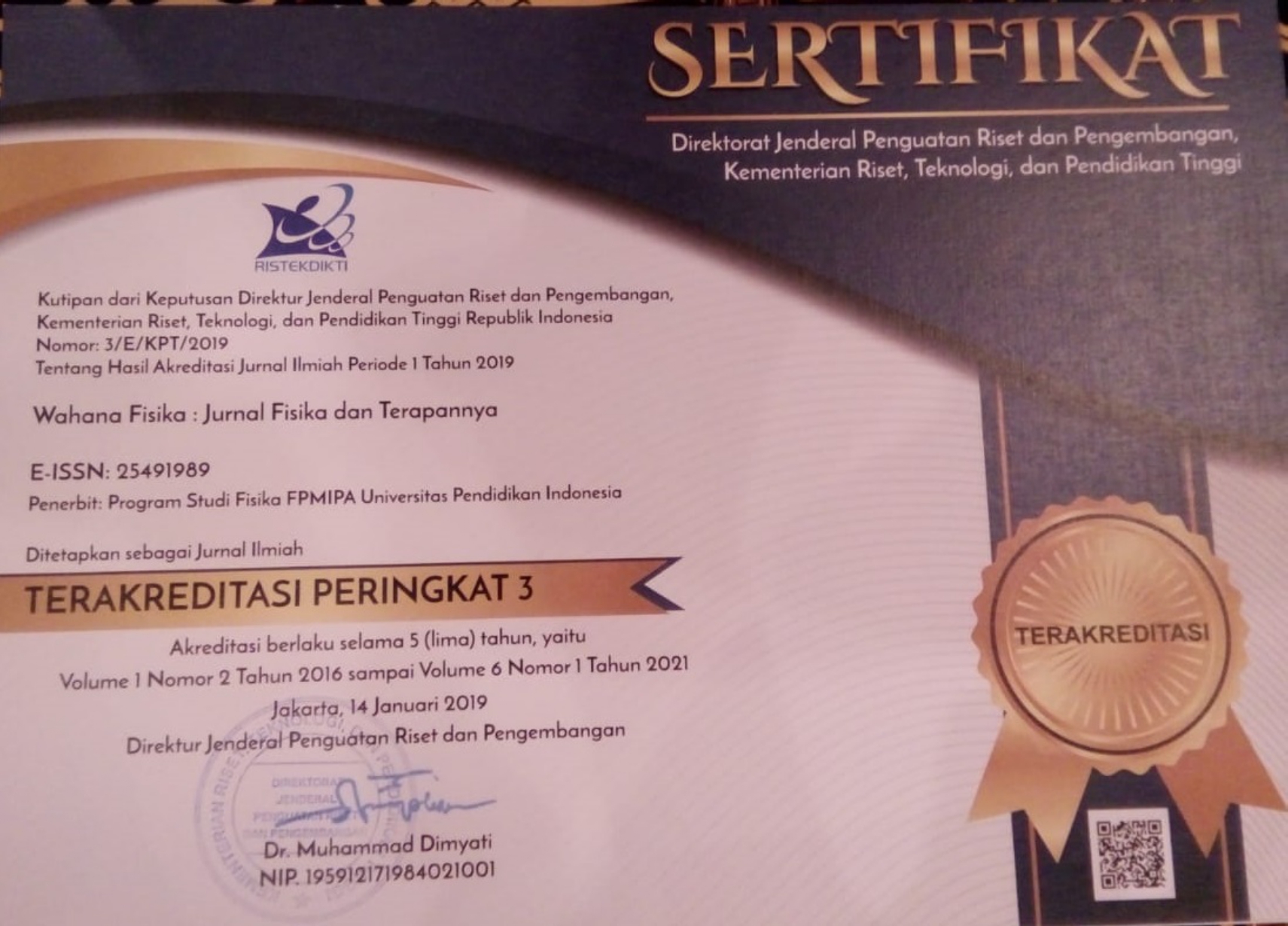Proses Transmetalasi Gd3+ pada Glomerulus Ginjal: Sebuah Studi Memanfaatkan Monte Carlo Cell
Abstract
Agen Kontras Berbasis Gadolinium (GBCA) telah dipakai sebagai agen kontras pertama sebagai media kontras Magnetic Resonance Imaging (MRI) pada tahun 1988. Gadolinium secara inheren beracun bagi manusia dalam bentuk bebasnya (Gd3+). Gadolinium (GBCA) membentuk ikatan kompleks yang stabil dengan agen kelat dan menciptakan pelindung untuk jaringan terhadap interaksi dengan ion Gd3+. Penelitian ini bertujuan untuk mengetahui bagaimana proses terdeposisinya Gd3+ dengan kelat linier pada organ glomerulus ginjal. Interaksi antara ion Gd3+ dan Zn2+ dapat mempengaruhi kompleksitas dari kelat pembungkus Gd3+proses ini disebut transmetalasi. Hasil interaksi Gd3+ dapat terdeposisi dan menjadi toxic bagi tubuh sehingga diperlukan simulasi untuk melihat proses mekanisme tedeposisinya Gd3+ dengan studi Monte Carlo Cell untuk memperoleh probabilitas maskimum. Variasi jumlah ion Gd3+ menunjukan bahwa semakin tinggi konsentrasi Gd3+, proses transmetalasi antara Gd3+ dan Zn2+ akan semakin banyak terjadi. Hal ini menyebabkan peningkatan jumlah kelat Gd3+ yang berikatan dengan Zn2+. Gd3+ yang terlepas dari kelat akan menjadi ion Gd3+ murni yang dapat terdeposisi pada organ glomerulus ginjal.
Full Text:
PDF (Bahasa Indonesia)References
Lohrke, J., Frenzel, T., Endrikat, J., Alves, F. C., Grist, T. M., Law, M., ... & Pietsch, H. (2016). 25 years of contrast-enhanced MRI: developments, current challenges and future perspectives. Advances in therapy, 33, 1-28.
Aime, S., & Caravan, P. (2009). Biodistribution of gadolinium‐based contrast agents, including gadolinium deposition. Journal of Magnetic Resonance Imaging: An Official Journal of the International Society for Magnetic Resonance in Medicine, 30(6), 1259-1267.
Ranga, A., Agarwal, Y., & Garg, K. (2017). Gadolinium based contrast agents in current practice: Risks of accumulation and toxicity in patients with normal renal function. Indian Journal of Radiology and Imaging, 27(02), 141-147.
Roberts, D. R., Welsh, C. A., LeBel, D. P., & Davis, W. C. (2017). Distribution map of gadolinium deposition within the cerebellum following GBCA administration. Neurology, 88(12), 1206-1208.
Ramalho, J., Semelka, R. C., Ramalho, M., Nunes, R. H., AlObaidy, M., & Castillo, M. (2016). Gadolinium-based contrast agent accumulation and toxicity: an update. American Journal of Neuroradiology, 37(7), 1192-1198.
Maximova, N., Zanon, D., Pascolo, L., Zennaro, F., Gregori, M., Grosso, D., & Sonzogni, A. (2015). Metal accumulation in the renal cortex of a pediatric patient with sickle cell disease: a case report and review of the literature. Journal of Pediatric Hematology/Oncology, 37(4), 311-314.
Bücker, P., Funke, S. K., Factor, C., Rasschaert, M., Robert, P., Sperling, M., & Karst, U. (2022). Combined speciation analysis and elemental bioimaging provide new insight into gadolinium retention in kidney. Metallomics, 14(3), mfac004.
Martino, F., Amici, G., Rosner, M., Ronco, C., & Novara, G. (2021). Gadolinium-based contrast media nephrotoxicity in kidney impairment: the physio-pathological conditions for the perfect murder. Journal of Clinical Medicine, 10(2), 271.
Kuntari, F. R., Pranoto, S., & Sutresno, A. (2019). Studi Proses Difusi melalui Membran dengan Pendekatan Kompartemen. Jurnal Fisika dan Aplikasinya, 15(2), 62-65.
Haryanto, B. (2008). Pengaruh Pemilihan Kondisi Batas, Langkah Ruang, Langkah Waktu dan Koefisien Difusi Pada Model Difusi. Petra Christian University.
Sari, E. R., Maslebu, G., & Sutresno, A. (2020). Studi Difusi Ca2+ Pada Sinapsis Menggunakan Metode Monte Carlo Cell. Jurnal Fisika dan Aplikasinya, 16(1), 50-54.
Andresta, E. D., Wibowo, N. A., & Sutresno, A. (2019). Investigasi Pengaruh Jarak Celah Sinapsis dengan menggunakan Metode Monte Carlo. Jurnal Fisika dan Aplikasinya, 16(3), 111-116.
DOI: https://doi.org/10.17509/wafi.v9i1.60674
Refbacks
- There are currently no refbacks.
Copyright (c) 2024 Wahana Fisika

This work is licensed under a Creative Commons Attribution-ShareAlike 4.0 International License.
Wahana Fisika e-ISSN : 2549-1989 (SK no. 0005.25491989/JI.3.1/SK.ISSN/2017.02 ) published by Physics Program , Universitas Pendidikan Indonesia Jl. Dr.Setiabudhi 229 Bandung. The journal is indexed by DOAJ (Directory of Open Access Journal) SINTA and Google Scholar. Contact: Here
 Lisensi : Creative Commons Attribution-ShareAlike 4.0 International License.
Lisensi : Creative Commons Attribution-ShareAlike 4.0 International License.







